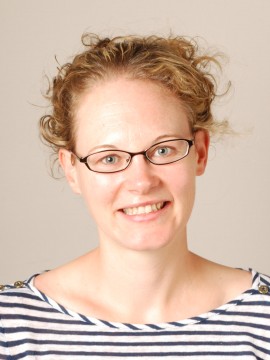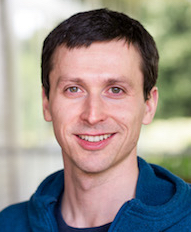Visualization Across UBC
This event is from 12:30 - 2:00pm and will have three talks.
Lunch is provided with RSVP.
RSVP Here
The Framing of Haptipedia - an expert-sourced collection of haptic inventions
Karon MacLean (Professor, Computer Science):
Karon MacLean is Professor in Computer Science at UBC, with degrees in Biology and Mechanical Engineering (BSc, Stanford; M.Sc. / Ph.D, MIT) and and time spent as a professional robotics engineer (Center for Engineering Design, University of Utah) and haptics / interaction researcher (Interval Research, Palo Alto). She has been at UBC since 2000, where she currently leads UBC’s Designing for People (DFP) interdisciplinary research cluster and CREATE graduate training program (20 researchers spanning 8 departments and 4 faculties - dfp.ubc.ca); and is Special Advisor, Innovation and Knowledge Mobilization to UBC’s Faculty of Science.
MacLean's research specializes in the design of haptic (touch) interactions: cognitive, sensory and affective design for people interacting with the computation we touch, emote and move with and learn from, from robots to touchscreens and the situated environment. Currently, her primary foci are physically therapeutic human-robot interactions; developing new classes of “nomadic” force feedback devices and interactions; and community-wide, orchestrating the development of a much-needed haptic design ecosystem supported by tools and guidelines.
Abstract
Today’s advances in tactile sensing and wearable, Internet-of-things and context-aware computing are spurring new ideas about the role and utility of touch-centered interactions, which in turn expose new technical and social design questions. But while haptic technology is improving (actuation, sensing and control), incorporating it into a real-world design process poses a major obstacle to adoption due to unique challenges and lack of tools and guidelines. Meanwhile, a related problem is the high disciplinary, generational and geographical fragmentation of this field, which has deeply hindered haptic designers’ ability to know about, incorporate and build upon others’ advances.
Haptipedia.org (developed jointly with Max Plank Institute for Intelligent Systems) is a community resource targeting the most basic of these deficiencies: finding and learning about past haptic inventions, whether as a device creator, and/or someone who wants to find haptic technology that’s suitable for incorporation into an application. Because haptic technology has many aspects, a mere catalog is insufficient; hapticians need to explore a collection from many perspectives, many of which the designers did not document or consider. Thus, in addition to a database (105 grounded force-feedback devices at present), we developed an attribute taxonomy and visualization at substantial manual and experimental effort. Our ongoing research uses Haptipedia as a tool to: study how hapticians with different backgrounds and purposes think about the haptic device attribute space; increase inter-field awareness; engage the haptics community, from issues of trust to expert-sourcing ongoing contributions and review; learn to semi-automate attribute processing; speed the adoption of usual descriptive standards; and, along with other tools in our ecosystem, alter the field’s design practices.
Data Visualization in Health Services and Health Policy
Sabrina Wong (Director, Centre for Health Services and Policy Research, Professor, UBC School of Nursing):
Dr. Wong’s research examines the organization and delivery of health care services within the context of primary health care. A recognized leader in research involving patient-reported quality of care, her work contributes to informing practice and system level interventions that seek to decrease health inequalities among Canadian residents, including people who face multiple disadvantages in accessing and using the health care system such as those who have language barriers and live in poverty. Her long-standing commitment to research has significantly contributed to further understanding and application of primary health care in helping to reduce health and health care inequalities.

Website
Dawn Mooney (Sessional Lecturer, Centre for Health Services and Policy Research):
Dawn Mooney works as a cartographer, geographer and data visualizer at the UBC Centre for Health Services and Policy Research and teaches cartography in the Department of Geography. She holds a BA in Geography (UBC 2003) and a Master of Public Health (UBC 2013). Her work at CHSPR focuses on mapping variations in health status, health services use, health human resources, and prescription drug use across BC and Canada. She is interested in methods of effective graphical communication of health data and statistics, and in using mapping to explore, communicate and address geographic disparities in health and health care.

Website
Abstract
Data visualization has a long history in health services and policy research. In 1854, John Snow mapped deaths from cholera alongside water pumps, helping to identify the source of the outbreak, and providing convincing evidence that cholera was a waterborne disease. In the same decade, Florence Nightingale observed that the majority of troop deaths in the Crimean War were due to preventable communicable disease, not wounds. John Snow’s visualization is foundational to modern epidemiology, and Nightingale’s work links to what we do today: analyze and visualize data in order to better provide health services to the population. Our talk is about the value of visualization in health services and policy research, with a series of examples divided into those that are primarily about data exploration and those primarily about communicating results and evidence to others. Examples focused on data exploration include using maps to visualize incidence of a rare lung disease, and using an interactive tool to explore chronic disease incidence and prevalence across time and geography in BC. Examples focused on communication include primary care performance portraits, an atlas of variation in use of prescription drugs across Canada, and an online dashboard of data from primary care electronic medical records.
Comparing Software Repositories Visually with RepoGrams
Ivan Beschastnikh (Assistant Professor, Computer Science):
Dr. Beschastnikh is an Assistant Professor in the Department of Computer Science at the University of British Columbia (UBC) He received his doctorate degree from the University of Washington in 2013. Dr. Beschastnikh has broad research interests that focus on systems and software engineering. His recent projects span distributed systems, formal methods, modeling and program analysis. Besides these core interests he also does research on how people collaborate (or fail to collaborate) in massive online communities, such as Wikipedia.
Abstract
The availability of open source software projects has created an enormous opportunity for software engineering (SE) research: studying the activity of software engineers is easier than ever before. However, this availability of projects requires that SE researchers judiciously select an appropriate set of evaluation targets and properly document this rationale. After all, the choice of targets may have a significant effect on an evaluation of a research proposal. In this talk I will describe a project that we pursued to help SE researchers with this task. In this project we developed RepoGrams, which supports researchers in qualitatively comparing and contrasting software projects over time using a set of software metrics. RepoGrams uses an extensible, metrics-based, visualization model that can be adapted to a variety of analyses. Through a user study of 14 SE researchers we found that RepoGrams can assist researchers in filtering candidate software projects and make more reasoned choices of targets for their evaluations. The paper that describes RepoGrams in detail is online: https://www.cs.ubc.ca/~bestchai/papers/repograms-msr16.pdf

Website
Please don't forget to RSVP!
Once you are inside the Forestry Science building walk to the rear (south-east) of the building by passing through the large open study area and up the stairs to the 2nd level student (“treetop”) lounge area. Turn left, pass through the double doors, and room 2300 will be immediately to your right.
